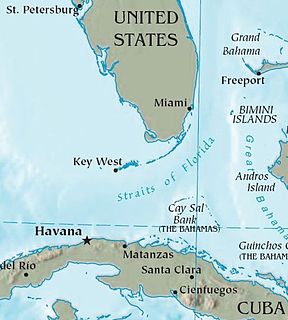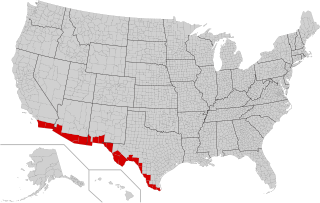
Operation Wetback was an immigration law enforcement initiative created by Joseph Swing, the Director of the United States Immigration and Naturalization Service (INS), in cooperation with the Mexican government. The program was implemented in June 1954 by U.S. Attorney General Herbert Brownell. The short-lived operation used military-style tactics to remove Mexican immigrants—some of them American citizens—from the United States. Though millions of Mexicans had legally entered the country through joint immigration programs in the first half of the 20th century, Operation Wetback was designed to send them back to Mexico.
Immigration reform in the United States is a term used in political discussion regarding changes to current immigration policy of the U.S.

The wet feet, dry feet policy or wet foot, dry foot policy was the name given to a former interpretation of the 1995 revision of the application of the Cuban Adjustment Act of 1966 that essentially says that anyone who emigrated from Cuba and entered the United States would be allowed to pursue residency a year later. Prior to 1995, the U.S. government allowed all Cubans who reached U.S. territorial waters to remain in the U.S. After talks with the Cuban government, the Bill Clinton administration came to an agreement with Cuba that it would stop admitting people intercepted in U.S. waters. For two decades thereafter, any Cuban caught on the waters between the two nations would summarily be returned to Cuba or sent to a third country, while one who made it to shore got a chance to remain in the United States, and later would qualify for expedited "legal permanent resident" status in accordance with the 1966 Act and eventually U.S. citizenship. On January 12, 2017, Barack Obama announced the immediate end of the policy.

The Mexico–United States border is an international border separating Mexico and the United States, extending from the Pacific Ocean in the west to the Gulf of Mexico in the east. The border traverses a variety of terrains, ranging from urban areas to deserts. The Mexico–United States border is the most frequently crossed border in the world, with approximately 350 million documented crossings annually. It is the tenth-longest border between two countries in the world.
Illegal immigration to the United States is the process of migrating into the United States in violation of federal immigration laws. This can include foreign nationals who have entered the United States illegally, as well as those who entered legally but then remained after the expiration of their entry visa or parole documents. Illegal immigration has been a matter of intense debate in the United States since the 1980s.

NEXUS is a joint Canada Border Services Agency and U.S. Customs and Border Protection-operated Trusted Traveler and expedited border control program designed for pre-approved, low-risk travelers. Members of the program can avoid waits at border entry points by using reserved lanes at land crossings into Canada and the United States, by using self-serve kiosks at airports in Canada, the US and some international locations, or by phoning border officials for a marine entry. A NEXUS membership card is a valid document under the Western Hemisphere Travel Initiative (WHTI), so it can be used in place of a passport, including by air if flying between the US and Canada.
Title 8 of the United States Code codifies statutes relating to aliens and nationality in the United States Code.

The Secure Electronic Network for Travelers Rapid Inspection (SENTRI) provides expedited U.S. Customs and Border Protection (CBP) processing, at the U.S.-Mexico border, of pre-approved travelers considered low-risk. Voluntarily applicants must undergo a thorough background check against criminal, customs, immigration, law enforcement, and terrorist databases; a 10-fingerprint law enforcement check; and a personal interview with a CBP Officer. The total enrollment fee is $122.50, and SENTRI status is valid for 5 years.
No More Deaths is an advocacy group based in Tucson and Phoenix, Arizona, United States, that seeks to end the series of fatalities of undocumented immigrants crossing the desert regions near the United States-Mexico border. Volunteers for the organization provide food, water, and medical aid to people crossing the US-Mexico border through the Arizona desert and offer humanitarian aid to people in Mexico who have been deported from the US.
Removal proceedings are administrative proceedings to determine an individual's removability under United States immigration law. Removal proceedings are typically conducted in Immigration Court by an immigration judge (IJ).

Colloquially, a coyote is a person who smuggles immigrants across the U.S.–Mexico border. The word "coyote" is a loanword from Mexican Spanish that usually refers to a species of North American wild dog (Canis latrans).

The United States government holds tens of thousands of immigrants in detention under the control of Customs and Border Protection and the Immigration and Customs Enforcement (ICE). Immigrants are detained for unlawful entry to the United States, when their claims for asylum are received, and in the process of deportation and removal from the country. During Fiscal Year 2018, 396,448 people were booked into ICE custody: 242,778 of whom were detained by CBP and 153,670 by ICE's own enforcement operations. A daily average of 42,188 immigrants were held by ICE in that year. In addition, over twelve thousand immigrant children are housed by facilities under the supervision of the Office of Refugee Resettlement's program for Unaccompanied Alien Children. Prior to referral to these other agencies, the CBP holds immigrants at processing centers; between mid-May and mid-June 2019, it held between 14,000 and 18,000 immigrants.
United States v. Valenzuela-Bernal, 458 U.S. 858 (1982), is a United States Supreme Court case that determined the constitutionality of deporting aliens who might give testimony in criminal alien smuggling prosecutions. Because deporting alien witnesses might take away a testimony that would be both “material and favorable” to the defendant, it gives rise to a potential motion from the defense to dismiss the indictment under the Compulsory Process Clause of the Sixth Amendment and the Due Process Clause of the Fifth Amendment.
Credible fear is a concept in United States asylum law whereby a person who demonstrates that he or she has a credible fear of returning to his or her home country cannot be subject to deportation from the United States until the person's asylum case is processed.
In United States immigration enforcement, "catch and release" refers to a practice of releasing a migrant to the community while he or she awaits hearings in immigration court, as an alternative to holding them in immigration detention. The migrants whom U.S. immigration enforcement agencies have allowed to remain in the community pending immigrant hearings have been those deemed low risk, such as children, families, and those seeking asylum.
Expedited removal is the term for a process related to immigration enforcement in the United States during which certain aliens are denied entry to and/or physically removed from the United States, without going through the normal removal proceedings. Whereas the legal authority for expedited removal allows for its use against most unauthorized entrants who have been in the United States for less than two years, its rollout so far has been restricted to people seeking admission and those who have been in the United States for 14 days or less, and excludes first-time violators from Mexico and Canada.
Stipulated removal is a summary deportation procedure used in immigration enforcement in the United States. Stipulated removal occurs when a noncitizen who is facing removal proceedings and is scheduled for a hearing with an immigration judge signs a document stipulating that he/she is waiving the right to trial and to appeal, and is prepared to be removed immediately. The stipulation of removal must still be signed off by the judge before whom the hearing is to take place, but the noncitizen need not be physically presented to the judge. It is authorized under Section 240(d) of the Immigration and Nationality Act of 1965 According to the United States Code of Federal Regulations: "A stipulated order shall constitute a conclusive determination of the alien’s removability from the United States." Stipulated removal applies only to those who are scheduled for regular removal proceedings, and does not apply to people who are being removed through other summary procedures such as expedited removal, reinstatement of removal, or administrative removal for aggravated felons.
Voluntary departure in the Immigration and Nationality Act (INA) of the United States is a legal remedy available to certain aliens who have been placed in removal proceedings by the former U.S. Immigration and Naturalization Service (INS) or the now Department of Homeland Security (DHS).

The Trump administration family separation policy was an aspect of US President Donald Trump's immigration policy. The policy was presented to the public as a "zero tolerance" approach intended to deter illegal immigration and to encourage tougher legislation. It was officially adopted across the entire US–Mexico border from April 2018 until June 2018.Under the policy, federal authorities separated children and infants from parents or guardians with whom they had entered the US. The adults were prosecuted and held in federal jails or deported, and the children were placed under the supervision of the US Department of Health and Human Services. In January 2020 the SPLC reported that the official government number of children separated from their parents or guardians under the policy was 4,368. Also in January, the American Civil Liberties Union reported that more than 1,100 families had been separated since June 2018, the date that the administration said they would no longer separate children from their parents.
Enforcement with consequences is the policy implemented within the US to help deter the rising tide of immigration that has grown in the US. It is the expansion of policy and consequences for people who choose to enter illegally and subjects them to legal, political and educational debates concerning legality status.








